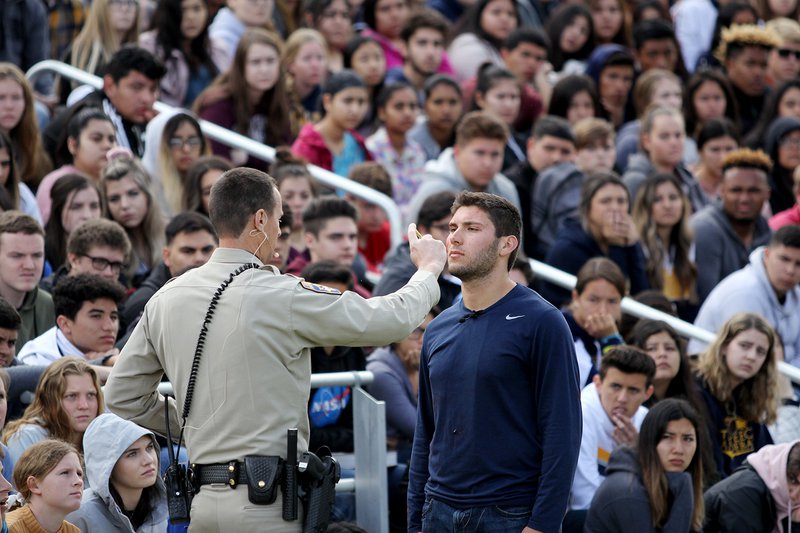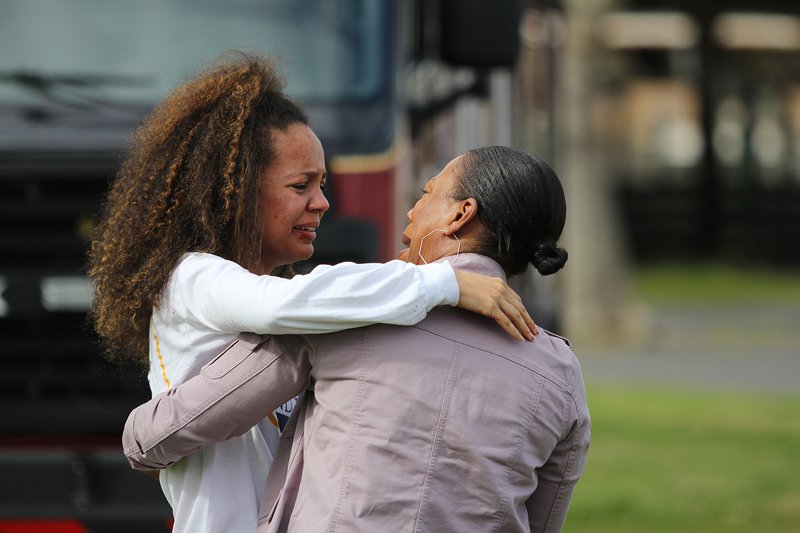Turlock High School student Cameran Sherwood had dreams of attending college in the fall, hoping to continue the success he’s found in both sports and academics. Those plans were shattered this week, however, when the senior football, basketball and tennis star chose to drink and drive, killing three of his classmates and earning himself a bed in a prison cell rather than a dorm room.
Luckily for Sherwood and others involved in Tuesday’s crash, his actions and their consequences were part of Every 15 Minutes — a two-day program that puts the real-life ramifications of drinking and driving into perspective for high school students.

Juniors and seniors from THS packed into bleachers at the Stanislaus County Fairgrounds on Tuesday morning where a terrible, simulated scene unfolded in front of them. Sherwood’s vehicle had collided with another car full of his peers, resulting in the deaths of students Lucas Curtis, Anthony Frias and Daisy Martinez. Though EMTs worked frantically to save them as the rest of the school watched on, all three succumbed to their injuries. Katie Dahlgren walked away as the crash’s sole survivor.
The Every 15 Minutes program is meant to be as realistic as possible for students, from the gory crash scene to the very real possibility that a drunk driver could rob them of someone they love in the blink of an eye. Students are typically selected based on their influence on campus, and the school tries to select a student from every social niche.
“It makes it more realistic when you see people that you know and care about. The thought of them dying is terrible,” said senior Megan Oliveira, who had gathered with the rest of the school’s juniors and seniors in the gym Wednesday morning for a mock funeral. “I know there are people in our class who do drink and drive, so hopefully this makes them realize it really is an issue and they need to stop.”

In addition to students who participated in the car crash scene, others were pulled from their classes throughout the day, with a student leaving class every 15 minutes — the average amount of time between each DUI-related fatality across the nation at the time the program began in the 90s.
Each student who “dies” in the program becomes part of a one-night, informational seminar that instills in them the dangers of drunk driving. Students also learn about distracted driving and, specifically, the devastating effects that can come from texting while operating a vehicle. Sherwood, the drunk driver, spent the night in jail.
He was cuffed and booked into the prison system just as any other drunk driver would be — a harrowing experience, he said.
“They make it seem so real, both being the ones who die and being the DUI driver,” Sherwood said. “The experience is what makes it so impactful for the kids.”
While participating in the program, the students don’t have their phones and are unable to communicate with their friends or their family. Parents whose children participate in the program have a meeting of their own that night, where they write letters to their children who have “died.”
Debbie Curtis’ son Lucas was one of the students involved in the simulated crash, and had to visit her son in the hospital where the doctor told her that despite their best efforts, her son couldn’t be saved.
“Obviously this was a reenactment of things that we know happen, but I was surprised at the reality of it all and the emotions I experienced throughout the day. It was far more real than I wanted it to be and expected it to be,” she said. “From the moment I got the call to rush to the hospital until 8 o’clock after the meeting last night, I probably didn’t go more than ten or fifteen minutes without tears streaming down my face.”
The program seems to have had an impact on students over the years, with the Center for Disease Control and Prevention now reporting that an alcohol-related automobile death occurs every 50 minutes.
“Traffic collisions are different than other ways of dying,” California Highway Patrol officer Tom Olsen told students on Wednesday. “They rob us of our loved ones, instantly. Fortunately, today we are in an environment where we can press rewind, reflect on the past and express our thoughts to those still with us.”
During Wednesday’s funeral for both the victims of the car crash and the other students who died on Tuesday, victims and their parents read letters to one another, speaking words that they would say if the unspeakable had never happened.
Sabrina Frias, Anthony’s mother, reflected on how she was just 17 when she gave birth to her son — the same age he was when he died in Tuesday’s accident. As she read, Anthony stood behind her with one hand on her shoulder, offering comfort in knowing that he wasn’t really gone.
“It tears me apart knowing that someone who was careless made a decision to drink and drive, which has now affected and changed so many lives forever,” Sabrina said. “That drunk driver stole the future football games that we should be watching your senior year. He stole the college experiences that you should have shared with us. He stole us being able to see the husband and father you would become one day. He stole a piece of my heart that will never be healed again. I’ll miss you more than you’ll ever know, but I can’t thank God enough for trusting us teen parents to raise such an amazing young man.”
At the end of the day, Sherwood’s cuffs were removed and Olsen recognized him as, in fact, a “really good kid.” Sherwood hopes that the lessons learned this week at THS will stick with his classmates for the rest of their lives.
“I hope we all take away how real this is, and how open we all are to something like this happening,” Sherwood said. “Find a designated driver. It’s not worth your life or risking someone else’s. When stuff like this happens, it doesn’t just impact your family. It’s like a ripple effect; it impacts so many other lives.”






